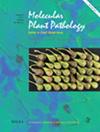大豆 MKK2 建立复杂的信号通路,调控大豆对胞囊线虫感染的反应
IF 4.8
1区 农林科学
Q1 PLANT SCIENCES
引用次数: 0
摘要
丝裂原活化蛋白激酶(MPK)级联在植物免疫和胁迫反应中发挥着核心信号作用。最近发现大豆 MPK 激酶 2 的直向同源物(GmMKK2)是一个潜在的信号节点,它在大豆胞囊线虫(SCN,Heterodera glycines)诱导的取食部位表达上调。为了研究 GmMKK2 在大豆-SCN 相互作用中的作用,我们利用转基因毛根过表达了一种无代谢活性的变体,称为激酶死亡变体(KD-GmMKK2)。KD-GmMKK2 的过表达显著降低了大豆对 SCN 的易感性,而野生型变体(WT-GmMKK2)的过表达对易感性没有影响。转录组分析表明,KD-GmMKK2 过表达植株通过组成性激活防御信号,特别是与几丁质、呼吸爆发、过氧化氢和水杨酸相关的防御信号,为抵抗 SCN 做好了准备。在 SCN 感染时,对 WT-GmMKK2 和 KD-GmMKK2 根样本进行磷酸蛋白组分析,确定了 GmMKK2 的 391 个潜在靶标。这些靶点参与了广泛的生物过程,包括防御信号、囊泡融合、染色质重塑和核组织等。此外,GmMKK2 还介导了许多转录和翻译调节因子的磷酸化,这表明除了典型的 MAPK 级联外,还有其他信号捷径可启动下游信号,最终调节基因表达和翻译启动。最后,通过过表达两种不同磷酸化蛋白 SUN1 和 IDD4 的磷酸化模拟变体和磷酸化死亡变体,验证了特定磷酸化位点对大豆响应 SCN 感染的功能要求。我们的分析共同确定了 GmMKK2 对调控大豆对 SCN 感染反应的信号模块的影响。本文章由计算机程序翻译,如有差异,请以英文原文为准。
Soybean MKK2 establishes intricate signalling pathways to regulate soybean response to cyst nematode infection
Mitogen‐activated protein kinase (MPK) cascades play central signalling roles in plant immunity and stress response. The soybean orthologue of MPK kinase2 (GmMKK2) was recently identified as a potential signalling node whose expression is upregulated in the feeding site induced by soybean cyst nematode (SCN, Heterodera glycines ). To investigate the role of GmMKK2 in soybean–SCN interactions, we overexpressed a catabolically inactive variant referred to as kinase‐dead variant (KD‐GmMKK2) using transgenic hairy roots. KD‐GmMKK2 overexpression caused significant reduction in soybean susceptibility to SCN, while overexpression of the wild‐type variant (WT‐GmMKK2 ) exhibited no effect on susceptibility. Transcriptome analysis indicated that KD‐GmMKK2 overexpressing plants are primed for SCN resistance via constitutive activation of defence signalling, particularly those related to chitin, respiratory burst, hydrogen peroxide and salicylic acid. Phosphoproteomic profiling of the WT‐GmMKK2 and KD‐GmMKK2 root samples upon SCN infection resulted in the identification of 391 potential targets of GmMKK2. These targets are involved in a broad range of biological processes, including defence signalling, vesicle fusion, chromatin remodelling and nuclear organization among others. Furthermore, GmMKK2 mediates phosphorylation of numerous transcriptional and translational regulators, pointing to the presence of signalling shortcuts besides the canonical MAPK cascades to initiate downstream signalling that eventually regulates gene expression and translation initiation. Finally, the functional requirement of specific phosphorylation sites for soybean response to SCN infection was validated by overexpressing phospho‐mimic and phospho‐dead variants of two differentially phosphorylated proteins SUN1 and IDD4. Together, our analyses identify GmMKK2 impacts on signalling modules that regulate soybean response to SCN infection.
求助全文
通过发布文献求助,成功后即可免费获取论文全文。
去求助
来源期刊

Molecular plant pathology
生物-植物科学
CiteScore
9.40
自引率
4.10%
发文量
120
审稿时长
6-12 weeks
期刊介绍:
Molecular Plant Pathology is now an open access journal. Authors pay an article processing charge to publish in the journal and all articles will be freely available to anyone. BSPP members will be granted a 20% discount on article charges. The Editorial focus and policy of the journal has not be changed and the editorial team will continue to apply the same rigorous standards of peer review and acceptance criteria.
 求助内容:
求助内容: 应助结果提醒方式:
应助结果提醒方式:


